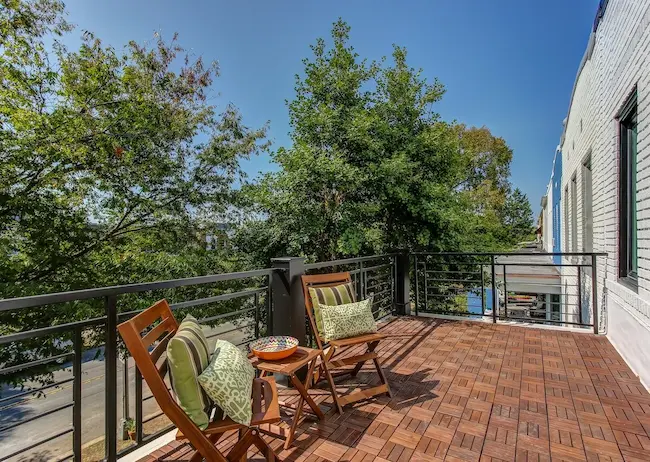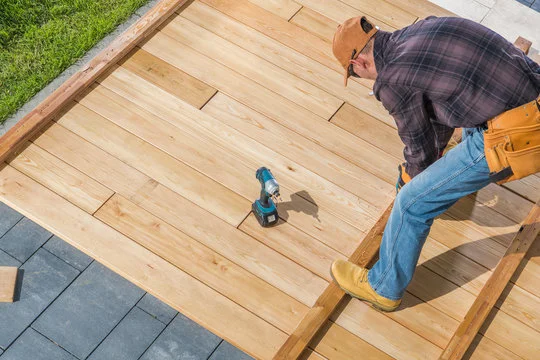As of 2025, constructing a new deck or decking remains among the most popular home improvement projects for creating an extra outdoor living space, and homeowners are showing a growing interest in the prices of materials and labor before diving into the construction projects.
According to the recent surveys, labor costs to construct a deck in the United States vary between $15 and $35/sq ft, with certain estimates ranging from $8 to $22/sq ft based on the contractor’s knowledge and skills, the design complexity, and seasonality.
As an example, a small 12 x 12 (144 sq ft) deck may cost around $57600-$86400, while a larger 20 x 20 deck, which is more complex, ranges between $16000 and $24000, again depending on the material.
It’s crucial to understand these figures as these rates may vary considerably due to geographic distinctions, local demand, permit and inspection demands, and site access. In this blog, we will cover the various factors that affect the labor cost to build a deck per square foot and the best materials for your projects.
Average Labor Cost to Build a Deck in 2025
The cost of professional labor to build a deck is a major cost determinant of the overall project price. Most often, various national labor rates depend on the experience of contractors, the complexity of the building, and the site conditions. Smaller decks tend to be more costly per square foot because the size of the involvement (set up and overhead) is spread over fewer square feet, and larger projects have the advantage of gaining scale economies.
One major difference between 2024 and the present day is the 5-8% rise in average labor rates across the country. This increase is attributable to the confluence of a shortage of skilled labor and increased demand for outdoor construction. Any homeowner with projects in 2025 should keep this increase in mind for budget planning, as the timing of the construction season may also influence the ultimate costs of the labor required.
| Deck Size | 2024 Labor Cost (/sq ft) | 2025 Labor Cost (/sq ft) | % Change |
| Small (≤150 sq ft) | $14 – $26 | $15 – $28 | +6% |
| Medium (151–300 sq ft) | $15 – $28 | $16 – $30 | +7% |
| Large (301+ sq ft) | $16 – $30 | $18 – $35 | +8% |
Factors Affecting Labor Cost Per Square Foot in 2025
The cost of labor deck construction varies extensively based on numerous different factors, and many of these factors are directly dependent on material selection and specifications of the project.
Material Cost and Installation Complexity
Installation of different decking materials requires a different degree of dexterity and time. As an example, jobs involving working with dense hardwoods such as walnut or oak (affected by the climbing prices of hardwood lumber) are inherently sensitive to both proper cutting and fastening. The latter often increases labor rates to the higher end of the scale. The poplar, having a cheaper price, is softer and hence tends to lower the number of labor hours required because it can be easily handled.

Quality & Preparation of the Board
The decision about the material could also have an impact on labor costs. Rough-cut boards are known as cheaper raw materials, and they may need more work in the form of on-site planing, sanding, and adjustments. This additional preparation cost adds to the price of labor per square foot.
Project Scale and Design
Designs that have layers or have features installed, or need custom-made railings, should naturally require more labor. Although it is not a deck, when the relative magnitude of planning is plotted against a project like a 30×40 pole barn build cost, one will recognize that the scale and complexity of design affect the amount of labor in home construction done outdoors.
Accurate Estimating Tools
Tools such as a Wood Price Calculator can also be used to provide accurate cost forecasting, not only in terms of material but also in the costs potentially involved in working particular species, be it easier poplar or the high-end black walnut board feet price.
Material Selection and Its Impact On Labor Cost
The decking material you select not only affects the looks of the deck and the durability of your deck, but it also has a direct bearing on the amount of labor dollars per square foot needed. Density, hardness, and the finishing properties of different woods differ, and this directly affects the time consumed during the installation process and consequently labor cost.
Although the hardwoods are sturdy and aesthetically pleasing, they usually require more cutting accuracy, sanding, and sealing. The softer ones are, however, easier to work with and might need to be replaced over time at a high rate. The pre-preparation requirements may seriously influence the work man-hours involved in installation.
Poplar Logs
Poplar is lightweight and easy to rip and fast to install. Its price of poplar logs is one of the lowest in the hardwood category, with an average of $2.502.50 to 4.50/per board foot in the year 2025. The softness of it usually leads to labor rates that are close to the lower end of the scale, averaging 15 to 20 dollars per square foot. It’s quite cost-effective and labor-efficient.
Black Walnut
Decks made out of black walnut are treasured due to their great grain and quality finish. The black walnut board feet price market price is approximately 10 to 15 U.S dollars per board foot in the year 2025. This wood is denser, which requires a slower, more thoughtful installation process, which tends to push labor costs to $28-35 per square foot. It’s comparatively expensive and needs extra care.
Amish Rough-Cut Lumber: as‑is, Heavy Prep
Although Amish Rough-cut lumber is a labor-saving option regarding the cost of materials, the lumber is not processed, making it very labor-intensive. Boards generally need to be planed, sanded, and sometimes re-sized before installation, which can tack another $2-$5 per square foot to labor cost on top of the breaking rate.
Cedar
Cedar has been one of the most favorite decking materials because of its natural resistance to rot and ease of work with. Its soft nature makes it easier to use than hardwood, hence it keeps the costs of labor down. Cedar costs around 3$-7$ per board foot in 2025, while labor required for it costs around 15-22 per square foot.
Redwood
Redwood has a luscious finish like certain hardwoods, but it much much lighter. In 2025, the material costs are approximately between $5 and 12 per board foot, and the labour costs are between $15 and 22/sq ft because of its simple installation. It’s a soft wood, hence it requires minimal labor for work.
Composite
Composite decking, e.g., Trex, has also gained popularity among homeowners who need a long-lasting deck with little maintenance. The cost of the materials is about $8-20 per square foot, with an additional 2-5$ per square foot since polycarbonate sheet material can not be carelessly installed without resulting in gaps or warping and thus possibly voiding the manufacturer’s warranty. It has a low upkeep and requires increased worker accuracy.
PVC & Aluminum
PVC and aluminum deckings are built with the most durable materials. Although they are rot-resistant and pest-resistant, their custom-made fasteners and techniques of installation add to labor time. The price of materials in 2025 ranges between 10-20$ per square foot, while labor cost ranges between 20-35$ per square foot.
| Material | 2025 Price (per board foot or sq ft) | Installation Difficulty | Estimated Labor Cost (/sq ft) |
| Poplar | $2.50 – $4.50 | Easy | $15 – $20 |
| Black Walnut | $10 – $15 | High | $28 – $35 |
| Amish Rough‑Cut Lumber | $3.00 – $6.00 | Moderate–High (prep required) | $20 – $30 |
| Cedar | $3.00 – $7.00 | Moderate | $15 – $22 |
| Redwood | $5.00 – $12.00 | Moderate | $15 – $22 |
| Composite | $12 – $22 per sq ft | High Precision | $18 – $28 |
| PVC / Aluminum | $10 – $20+ per sq ft | Specialized | $20 – $35 |
How Hardwood Lumber Prices Affect Deck Building Labor
High prices of hardwood lumber have been impacting materials budgets as well as labour rates in the construction of decks. Oak, maple, and black walnut are hardwoods, and thus denser and heavier than softwood substitutes, thus demanding special tools, precision cutting equipment, and increased time of installation. The higher the price of premium hardwood, the more labor time that a contractor will put into doing quality workmanship to justify that investment, making the labor rate tend to go higher into the upper end of the price range of 15 to 35 per square foot.

Also, when high-quality hardwoods are sourced, occasionally rough-cut boards or milled to custom specifications are obtained, and this requires on-site modifications. These additional preparation activities, from trimming to finishing, increase the total work input. As a homeowner, knowing that the cost of surrounding labor is also a factor in determining the cost of hardwood lumber can be key to comparing the overall project estimates, since a higher lumber price can be an indicator of a labor-intensive structure.
Estimating Total Costs by a Wood Price Calculator
A Wood Price Calculator can be a useful tool in helping the homeowner get an estimated overall cost of their material. You can combine this with known labor costs per square foot to build a complete deck cost estimate by entering a board foot quantity and type of species.
Example:
- You need 400 board feet of cedar at $3.50/bf = $1,40
- Labor at $18/sq ft for 250 sq ft deck = $4,500
- Total Estimate: ~$5,900
Why a 30×40 Pole Barn Offers a Clear View of Deck Labor Expenses
A 30 x 40 pole barn is a different form of structure than a deck, but the labor to construct this type of building could be used as a basis of comparison when estimating the amount of labor required when building an outdoor project. As of 2025, a 30X40 pole barn cost would probably be around $25-50, with the labor being 30-40% of the price.
This comparison brings out an important lesson in deck projects, i.e., the more complex and large the structure, the more the labor component of the project price. Barns take special framing, finishing, and just as these necessitate more time, skill, and a larger crew, so do multi-level designs with elaborate deck structures. Awareness of these similarities gives homeowners an idea of how bigger decks may affect labor rates.
Conclusion
In 2025, building a deck per square foot requires proper budgeting and project planning of the cost of labor, which cannot be done without estimates and calculations. Its rates can vary between 15 and 35 dollars per square foot, and thus the labor bill will depend on the materials (type, qualities, etc.), design, geographical wages, and site conditions. The cost of using premium wood could prove more expensive because of the time it takes to prepare and set up, and cheaper wood could cost less.
As a homeowner, the three factors that will help you control the labor costs include being selective of materials, timing, and estimates. Whether you build a simple platform or a large, multi-tiered deck, grounding yourself in the realities of labor costs will give you a clear picture of budget planning and add value to your long-term investment in your property.
Frequently Asked Questions
How much does deck building cost on average per square foot in 2025?
The average labor cost associated with building a deck varies between 15 and $35 every square foot in 2025. The lower range can be designed with simple themes and sites, whereas the upper end of the sector can be designed with multi-wood or multi-tier, or complex designs.
2. Does the decking material affect the labor price?
Yes. Poplar and other materials are less demanding to work with, hence reducing the cost of labor. High-end materials such as black walnut or Amish rough-cut lumber are prepared differently and with more care, and hence will cost more labor hours, raising square-foot costs.
3. What effect do regional variations have on deck labor rates?
Prices of labor also differ depending on the place because of the cost of labor, demand in that place, and the regulation of building processes. Take the Northeast/West as an example, with labor rates potentially reaching $30-35/sq ft, whereas in the Midwest/South, labor costs reach $15-25 per square foot.
4. Does off-season construction lower labour costs?
Yes. The labor costs may also be reduced by hiring deck builders at the beginning of late fall or winter, when demand is lower, and contractors might compete with each other and present a much better price in order to have work in odd months.

